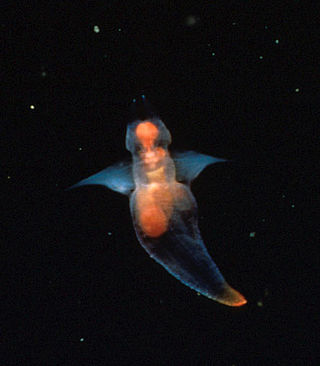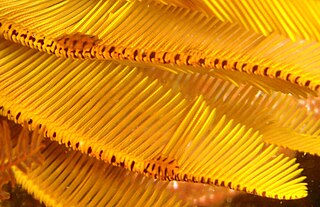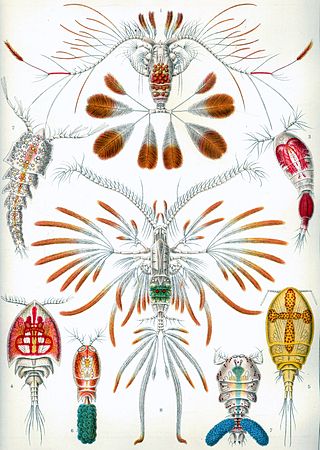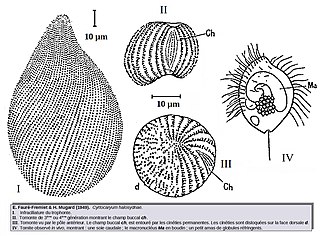
The Clionidae are a family of sea angels, which are a group of pelagic marine gastropods.

The Hyperiidea are a suborder of amphipods, small aquatic crustaceans. Unlike the other suborders of Amphipoda, hyperiids are exclusively marine and do not occur in fresh water. Hyperiids are distinguished by their large eyes and planktonic habitat. Most species of hyperiids are parasites or predators of salps and jellyfish in the plankton, although Themisto gaudichaudii and a few relatives are free-swimming predators of copepods and other small planktonic animals.

The Myzostomida or Myzostomatida are an order of small marine worms, which are parasitic on echinoderms, mostly crinoids. These highly unusual and diverse annelids were first discovered by Friedrich Sigismund Leuckart in 1827.

Speleonectidae is a family of remipedes in the order Nectiopoda. There are at least two genera and about seven described species in Speleonectidae.

Heteroconchia is a taxonomic infraclass of diverse bivalve molluscs, belonging to the subclass Autobranchia.

AlgaeBase is a global species database of information on all groups of algae, both marine and freshwater, as well as sea-grass.

The Tremellomycetes are a class of dimorphic fungi in the Agaricomycotina. Some species have gelatinous basidiocarps or (microscopically) a sacculate parenthesome. There are six orders, 17 families, and 39 genera in the Tremellomycetes. Tremellomycetes include yeasts, dimorphic taxa, and species that form complex fruiting bodies. Tremellomycetes include some fungi that are human and animal pathogens in the genera Cryptococcus, Naganishia, Papiliotrema, and Trichosporon and some fungi that are cultivated for food in the genera Tremella and Naematelia.
Etyiidae is a prehistoric family of dromiacean crabs only known from Cretaceous and a few Paleocene fossils.
The World Register of Marine Species (WoRMS) is a taxonomic database that aims to provide an authoritative and comprehensive list of names of marine organisms.

Muricodrupa is a genus of sea snails, marine gastropod mollusks in the subfamily Ergalataxinae of the family Muricidae, the murex snails or rock snails.

Pholas is a taxonomic genus of marine bivalve molluscs in the subfamily Pholadinae of the family Pholadidae.

Antipathidae is a family of corals in the order Antipatharia, commonly known as black corals. They are generally considered a deep-water taxon; however, some of the most diverse communities are known from tropical shallow waters.
Enoplida is an order of nematodes. It is one of two orders in Enoplia, which is one of two subclasses in Class Enoplea.

Artotrogidae is a family of copepods in the order Siphonostomatoida.

The clade Multicrustacea constitutes the largest superclass of crustaceans, containing approximately four-fifths of all described crustacean species, including crabs, lobsters, crayfish, shrimp, krill, prawns, woodlice, barnacles, copepods, amphipods, mantis shrimp and others. The largest branch of multicrustacea is the class Malacostraca.

The Hexanauplia is a clade proposed by Oakley et al. (2013) that constitutes a class of crustaceans, comprising the Copepoda and Thecostraca. A number of recent phylogenomic studies have not found support for this clade, with some supporting the alternative clade of Communostraca comprising Thecostraca and Malacostraca.
Haliris is a genus of the class Bivalvia of the family Verticordiidae.
Corticium is a genus of sponges in the order Homosclerophorida first described by Eduard Oscar Schmidt in 1862.

Kinetofragminophora is a class of Ciliophora. WoRMS said we shall disuse this classification.














